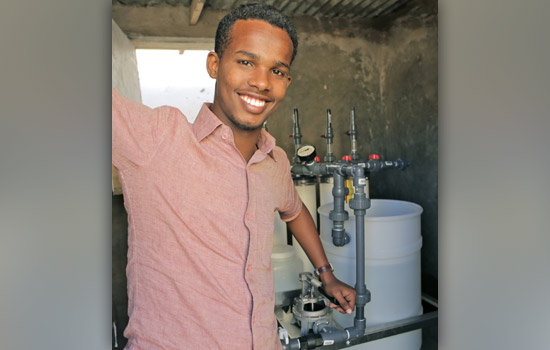Water purification system is changing lives
Healing Waters International purification system is featured exhibit at Lowenthal Hall
Water, water everywhere and not a drop to drink . . .
Rachel Carson-Silent Spring
Clean drinking water represents life.
And it’s a precious commodity if you live in countries where there is a limited supply—places like the Dominican Republic, Uganda, Somalia, Guatemala and Mexico.
RIT Imagine festivalgoers visiting Lowenthal Hall, home to Saunders College of Business, will be able to sample water from a Healing Waters International purification unit, which operates without a power source, lasts an average life span of 10 years, and can produce 250 to 3,500 gallons of clean water a day.
“Half of all human disease on the planet is a result of waterborne pathogens,” said Healing Waters CEO Ed Anderson. “Bad water is responsible for 2 million deaths per year, and almost all are children under 5 years old.
“RIT students are helping Healing Waters International get the word out: $25 provides safe water for life for one person. Come see us.”
Michael Palanski, assistant professor in management at Saunders College, had an inside link to Healing Waters, a nonprofit ministry located in Golden, Colo., that offers safe water and sanitation solutions to some of the poorest communities in the world. He just happens to be good friends with Anderson.
“Ed was an executive at Xerox for many years and I knew him and his wife, Joyce, when they lived here in Rochester back in the 1990s,” said Palanski. “After talking to him last fall in Denver, I decided to initiate a living case study for my leadership and organization class—where students could learn about strategic leadership at the top. If you’re a CEO, what are some of the problems you face?”
According to Palanski, the purification units are $15,000 and typically there is a third-party sponsor, usually a church in the United States that fundraises to secure a unit to be used in areas of need. Healing Waters not only analyzes and cleans dirty water in impoverished areas, but provides a site manager who oversees the unit, a health and hygiene trainer for children and adults, and a water systems manager who establishes hours of operation and builds community trust.
“One of the challenges Healing Waters is facing is that although their operations are very lean, they still have overhead to cover,” explained Palanski. “It’s a piece of cake for donors to fund $15,000 for a purification unit, but they think twice about giving $25,000 toward someone’s salary. So this is a strategic challenge for students to come up with solutions—whether it’s through something like social media or seeking partnerships with donors.”
Will Anderson be visiting RIT during the festival?
“He’s out in the field quite a bit, but is planning to come with his wife and a team from Healing Waters to Rochester for the festival,” said Palanski. “Ed will be our celebrated guest this year.”
Note: One of nine colleges at RIT, Saunders College of Business is accredited by the Association to Advance Collegiate Schools of Business International (AACSB International) and enrolls more than 1,200 undergraduate and graduate students. Saunders College and its entrepreneurial Venture Creations Incubator work in partnership with RIT’s Albert J. Simone Center for Student Innovation and Entrepreneurship to integrate business education with RIT’s world leading technical and creative programs. Graduate programs include Master of Business Administration, MBA-Accounting, Executive MBA and master’s degrees in finance and administration.
 Ahmed Osman samples water from Healing Waters purification unit in Somalia.
Healing Waters International
Ahmed Osman samples water from Healing Waters purification unit in Somalia.
Healing Waters International















